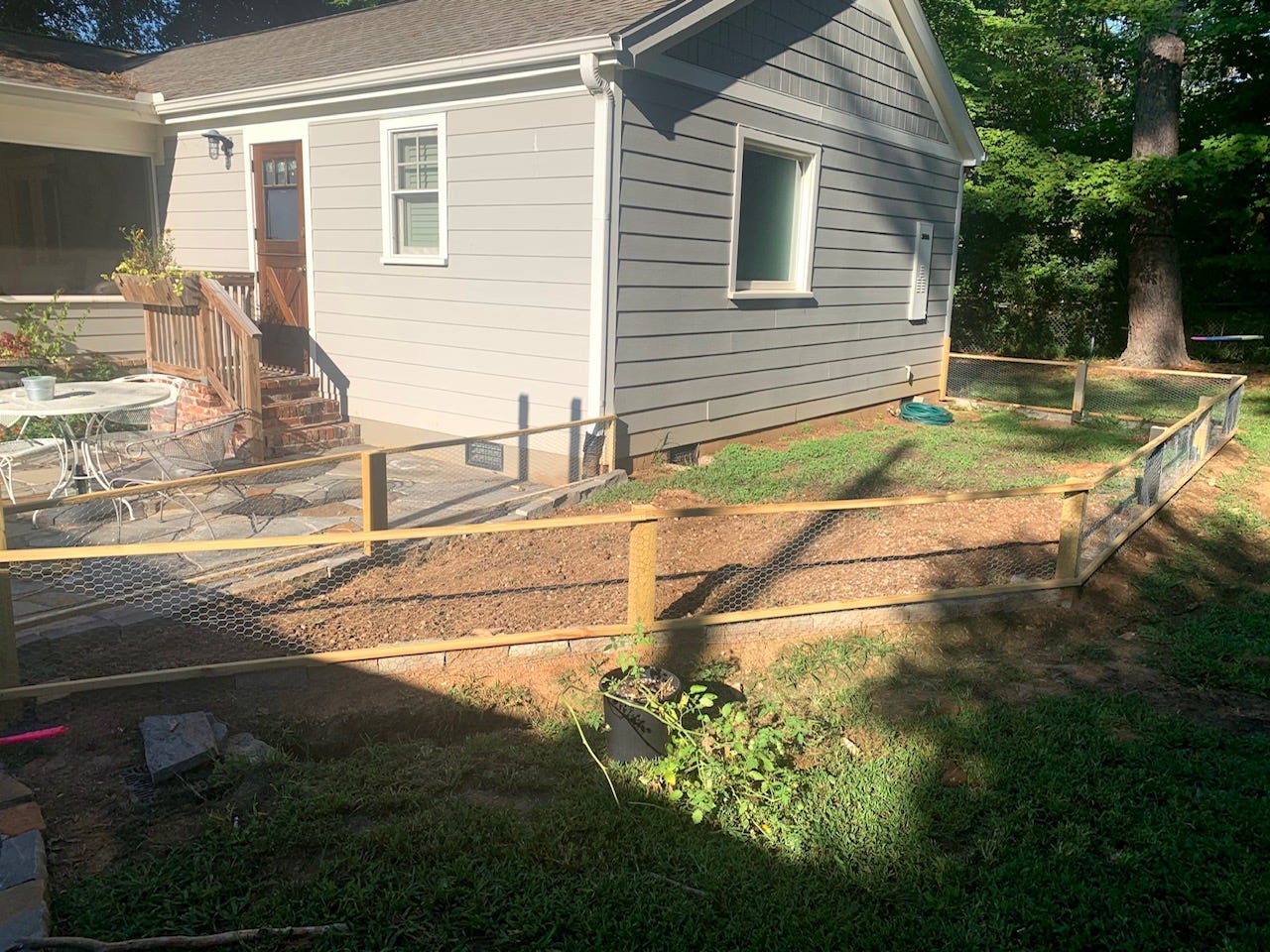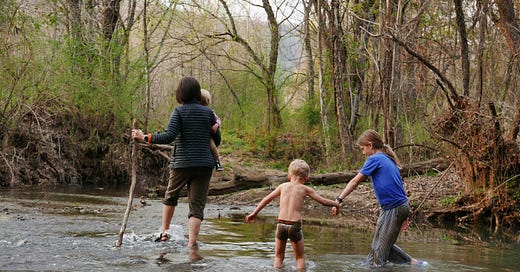April is here and if you are like us, you are behind. At least you feel behind. I encourage you to be ok with that. Especially with your garden. We have a long growing season ahead and there is time. April is usually when we see our final frost. Will we get another frost here in Alabama? My feeling a week ago was “no”, but during the next few nights I’m sure our valley will be frosted. Even so, soil temperatures are rising. A lot of folks only think about air temperature when it comes to plants, but the soil temperature is arguably more important.
For example, day time temperatures might consistently hit the upper 70s and lower 80s, but if nighttime temperatures are dipping into the 30s and 40s still, it is likely the soil isn’t going to reach the ideal temperature for tomatoes, peppers, squash, cucumbers, and okra until night time temperatures consistently stay above 55 degrees. So, what that means is, warm season crops like those I mentioned will not thrive and will grow very slowly. Their weakened state will make them more susceptible to disease and pest pressure.
Long story short, if you feel behind, don’t all of a sudden rush out and start planting just to plant. Be patient. You have time.
I’ve started a practice of really trying to notice the seasonal changes around me. Our last post was about it. April is sure to bring a lot of seasonal changes. I’m looking forward to witnessing it.
April is also shaping up to be the busiest month we’ve had in a long time. With four kids, each living active and relational lives, finding time to make progress on projects here at home and around the farm is difficult. Our lives are full.
Is it possible to hold the feelings of gladness and sadness together? Life is sad. It is also beautiful. I remember hearing a dad retelling the story of walking his daughter down the aisle. Before giving her away to be cared for by another man, he locked eyes with his daughter for a brief moment. In that moment, countless words, stories, moments, and feelings were shared between them – all unspoken, but felt deeply. He said that moment made all the sacrifices he had made for his daughter worth it.
As a parent myself, I relate. It is often these brief, unexpected moments with my children where I experience the greatest joy as a parent. While these moments are fleeting, they leave behind in me trails of comfort, gladness, joy, and yes - sadness.
So here we are – April. A quarter of the way through the year already and it feels like we haven’t even started. A busy month ahead of us with projects, chores, practices, games, and goals written on our calendar. But within it all, there are precious moments waiting for me.
This April, in all of its fullness, may we all live presently enough to fully experience these moments.
Last Frost Date
In the south, April, not March, is the month we get to forget about cold weather and plant our favorite warm season crops. It’s always funny to me how the big-box garden stores start pushing out the warm season vegetables and flowers in early March. It never fails. We warm up to the 70s for a few days, trees begin to bloom, and folks can’t help but buy plants for their gardens and yard. Those big-box garden stores love it. They know, in a few weeks, many of those same people will be back to buy those same plants because there is almost always a late freeze before we get into the meat of April. It’s like clockwork.
As far as determining your frost date … can I be honest? Things keep changing. Generally I’d say look at the USDA Hardiness Zone Map and find your zone. Then follow this:
Zone 6 (Kentucky-ish): Avg. last spring frost is April 30
Zone 7 (Tennessee and N Alabama - ish): Avg. last spring frost is April 15
Zone 8 (Much of Alabama) - Avg. last spring frost is April 1
If you just want to put in your zip code and have a date spit out for you, try this website: https://www.almanac.com/gardening/frostdates Their results seem pretty accurate.
🏡 In the Garden
I highly encourage mulching in your garden. It has a lot of positives and is a must for those of us who do not till. However, there are a few downsides of mulching. The one I want to mention here is this: mulch will keep you garden soil cooler in spring as the temperatures rise. The problem with this is, warm-season crops, such as tomatoes and peppers prefer warm soil. If their soil isn’t in the 70s, they aren’t going to grow. With this in mind, pull your mulch back in the areas where you are going to plant your warm-season crops (tomatoes, peppers, eggplant primarily) a week or two before planting. That means now! This will help your soil warm up in time for planting.
👉 Direct Seed in late April after threat of frost has passed and soil temperatures have risen: Beans, Cucumbers, Squash, Cantaloupe, Watermelon, Okra, and Sweet Corn
👉 Transplant after threat of frost has passed and soil temperatures have risen: Tomatoes, Peppers, Basil, Eggplant
👉 Plant Sweet Potato Slips in late April
Some Timely Tips
✔️ Early spring is also the time to plant blackberries, raspberries, and blueberries.
✔️ Any shrubs or trees planted in the spring will need to be watched carefully, watered deeply, and mulched heavily. It is important to not allow these plantings to dry out.
Seasonal Living
If you don’t have a garden, what better way to welcome spring than by putting in a new garden. I talk about how we put in our garden in this newsletter and here in this podcast.
Here are the highlights for anyone putting in a new garden:
First, understand which way is north. This is important because this will tell you which way shadows will be facing throughout the year. Your garden should go on the southern side of tall structures or trees!
Consider how storm water moves across your property and where it collects! Avoid areas that get really boggy after heavy rains or areas where a lot of run off moves through.
Think about your soil. The most important thing to consider here is contamination. If you or the previous owner had an old car sitting out for a few years in the spot that you want to put your garden, it’s probably a bad idea to put your garden there. Other than an outlier situation like that, I’m of the opinion, most soils can be remedied and brought back to life.
Do you want an in-ground garden or a raised bed garden? My suggestion is: If a raised bed garden means you must wait or makes you feel overwhelmed, definitely go the in-ground route! That’s what we do and it’s the way I prefer.
So you have your spot picked out, now what? Weed whack everything down to the ground, add a couple inches of compost and peat moss, cover with mulch, and then plant directly into soil. Remember to pull your mulch back when you plant and don’t incorporate your mulch into your soil. It can really be this easy.
Get some tools. To get started you need a stirrup hoe for weeding, a garden fork to aerate your soil, and a yard rake to move mulch around.
***Bermuda Grass Disclaimer*** So, Bermuda grass really messes up the above plan. If you weed whack Bermuda grass, add compost, peat moss, and mulch on top, then plant into it… You’re going to curse me and rightfully demand your money back. So let me say this, if you have a Bermuda grass yard and want to garden, please email me directly - Taylor@acommonlife.co. Eventually I am going to do a whole write-up on how to deal with Bermuda grass. Until then, email me and I’ll be happy to advise.

🍓 Seasonal Eating
Strawberries will be coming in this month! Look for them at roadside stands and at farmer’s markets!
🌕 Lunar Calendar
In modern times, the common name for April's full moon is the Pink Moon, while an old Anglo-Saxon term for it was Paschal Moon, referring to the death, burial, and resurrection of Jesus Christ. The “pink” part of it’s name is an ode to a wildflower that is native to the eastern portion of North America: the Pink Phlox. Where Morgan and I are located, in north Alabama, we usually see the first wild phlox bloom on our farm in late March.
This year, you can catch the full Pink Moon on the evening of Tuesday, April 12th.
📅 Calendar of Firsts
A calendar of firsts serves as a meaningful tool to celebrate and connect with the ever-changing rhythms of nature throughout the year. Its purpose is to document and acknowledge the first occurrences of various events and natural phenomena that mark the transition of seasons. By recording the first blooming flowers, migrating birds, or changing foliage, individuals deepen their awareness of the subtle shifts that unfold in the natural world. This heightened observation cultivates a sense of awe and appreciation for the beauty and diversity of our environment. Moreover, a calendar of firsts invites us to engage in a deeper relationship with the natural world, fostering a sense of connection, mindfulness, and gratitude. It allows us to truly immerse ourselves in the present moment and develop a greater understanding of the intricate cycles that shape our lives and the world around us.
April firsts to be looking for:
Remember these are general examples for zone 7 in the southeast US. Specific occurences will depend on your regional climate and conditions. Keeping a personal calendar or journal will allow you to capture the unique experiences and observations of each month in your region.
First bite of a fresh strawberry!
Return of hummingbirds from winter habitats
Emergence of butterflies and bees as they become more active (I saw my first butterfly on March 12th!)
First frog or toad choruses in wetlands or bodies of water (Heard my first toad chorus on February 2nd :-O)
First farmer’s market visit
First clear night for star gazing








The reminder of “it’s the soil temp not the air temp” is golden in thinking about planting those warm weather crops. Thank you for the reassurance that I’m not as behind as I thought.
The family picture is wonderful! V and W2.0’s relationship is beautifully illustrated and W1.0 is off doing his own thing somewhere.